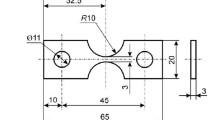Abstract
External test variables such as rate and temperature, and changes in alloy composition are shown to have a number of effects on the fracture of high-strength, metastable austenitic steels. One rate-dependent phenomenon is an unusual fracture mode transition wherein a flat mode changes to a shear mode when the amount of transformation product in the vicinity of the crack tip is reduced by adiabatic heating. The point at which this happens in any one test is dependent upon the velocity of the slowly growing crack which in turn is dependent upon the crosshead rate. Because of this rate effect, the plane stress fracture toughness decreases by as much as 30 pct at higher crosshead rates. Fractographically, it was ascertained that at room temperature, both phases failed in a ductile manner, but at −196°C, martensite containing greater than about 0.27 wt pct C would cleave. This resulted in a “ductile-brittle” transition in metastable austenites at −196°C as a function of carbon content. Other compositional variations change the austenite stability which controls the amount of strain-induced marteniste occurring at the crack tip. It is shown that a plane stress fracture toughness (K C) approaching 500,000 psi-in.1/2 may be achieved by decreasing the stability of the austenite. The variation ofK c with austenite stability agrees qualitatively with a theoretical model for the invariant shear contribution to the fracture toughness of metastable austenites.
Similar content being viewed by others
References
W. S. Pellini: NRL Report 6957, September, 1969.
L. Raymond:Fracture: Proc. of the Second Tewksbury Symp., p. 241, 1969.
S. J. Matas, M. Hill, and H. P. Munger:Metals Eng. Quart. ASM, 1963, vol. 3, no. 3.
S. D. Antolovich:Trans. TMS-AIME, 1968, vol. 242, p. 2371.
W. W. Gerberich, P. L. Hemmings, V. F. Zackay, and E. R. Parker: inFracture 1969, P. L. Pratt, ed., p. 288, Chapman and Hall, Ltd., London, 1969.
V. F. Zackay, E. R. Parker, D. Fahr, and R. Busch:Trans. Quart. ASM, 1967, vol. 60, no. 2, p. 252.
W. W. Gerberich, G. Thomas, E. R. Parker, and V. F. Zackay:Second Intern. Conf. on the Strength of Metals and Alloys, III, p. 894, Asilomar, Calif., August, 1970.
W. W. Gerberich, P. L. Hemmings, M. D. Merz, and V. F. Zackay:Trans. Quart. ASM, 1968, vol. 61, no. 4, p. 843.
W. F. Brown, Jr. and J. E. Srawley:ASTM Spec. Tech. Publ. 410, p. 130, Philadelphia, 1966.
G. R. Irwin:Weld. J. Res. Suppl., November 1962, p. 519S.
K. Schönert and R. Weichert:Chem. Ing. Techn., 1968, vol. 41, p. 295.
C. Dokko: UCRL Report 19068, University of California, Berkeley, September, 1969.
W. W. Gerberich, P. L. Hemmings, and V. F. Zackay:Trans. TMS-AIME, 1969, vol. 245, p. 1126.
C. Kittel:Solid State Physics, J. Wiley & Sons, New York, 1956.
C. J. Smithells:Metals Reference Book, Vol. II, Butterworths and Co, London, 1962.
J. Weertman: inProc 1st Intern. Conf. on Fract., Vol. 1, T. Yokobori, T. Kawasaki, and J. Swedlow, eds., p. 193, Japan Soc. for Strength and Fracture of Materials, Tokyo, 1965.
R. M. N. Pelloux: inFracture 1969, P. L. Pratt, ed., p. 731, Chapman and Hall, Ltd., London, 1969.
V. F. Zackay, W. W. Gerberich, and E. R. Parker, inFracture, Vol. 1, H. Liebowitz, ed., p. 396, Academic Press, New York, 1968.
G. Chanani: Ph.D. Thesis, Univ. of Calif., Berkeley, 1970.
W. W. Gerberich and J. Birat:Intern. J. Fract. Mechanics, 1971, vol. 7, p. 108.
H. Bernstein and G. C. Yound: NAVORD Report 6496 (Part 21, NRL 108), Naval Res. Lab., January, 1960.
Rept. ML-TDR 64-236, Boeing-North American, Wright Field, October, 1964.
Author information
Authors and Affiliations
Additional information
W. W. GERBERICH, formerly with the Lawrence Radiation Laboratory, Berkeley.
Rights and permissions
About this article
Cite this article
Gerberich, W.W., Hemmings, P.L. & Zackay, V.F. Fracture and fractography of metastable austenites. Metall Trans 2, 2243–2253 (1971). https://doi.org/10.1007/BF02917557
Received:
Issue Date:
DOI: https://doi.org/10.1007/BF02917557




